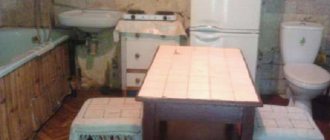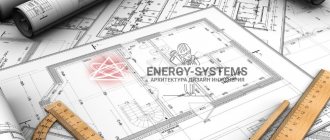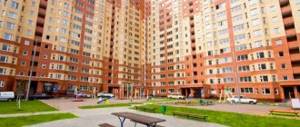To remodel a kitchen, general principles are used, which should be followed based on current legislation, as well as following the requirements of supervisory authorities.
Dear readers! The article talks about typical ways to resolve legal issues, but each case is individual. If you want to find out how to solve your particular problem , contact a consultant:
+7 (499) 938-81-90 (Moscow)
+7 (812) 467-32-77 (Saint Petersburg)
8 (800) 301-79-36 (Regions)
APPLICATIONS AND CALLS ARE ACCEPTED 24/7 and 7 days a week.
It's fast and FREE !
But there are also cases when remodeling a kitchen becomes impossible due to non-compliance with several rules.
Standard Rules
Apartments in old houses usually have an unusual layout, in which the living rooms have a large area, while the kitchen is only a few square meters.
For a modern person, such an area cannot be comfortable, since neither a good kitchen set nor large comfortable furniture can be placed here. To correct this situation, redevelopment is often resorted to.
Remodeling the kitchen occurs on the same basis as refurbishment of other rooms.
- You need to rely on Articles 25 and 26 of the Housing Code.
- But for the kitchen area there is a special decree, which was issued by the Government in 2006 under number 47.
It says that the kitchen cannot be moved into the living space. It can only be located above non-residential premises.
If there is a living room or hall under the area through which it is planned to expand the kitchen, then such redevelopment is prohibited.
Doing kitchen renovations right
It is more difficult to plan a kitchen renovation than, say, a bedroom or living room. Here you need to take into account many important points in advance - the location of sockets, the layout of the kitchen unit, storage, etc. How to renovate your kitchen beautifully and cheaply? Where to begin? Let's talk about everything in order and talk further.
Disappointment in the final result, unforeseen costs that do not fit into the allotted budget - these are only a small part of the consequences that you may encounter if you do not think through the stages of repair, the purchase of materials and design in advance.
Mistakes cost money.
To prevent your renovation from turning into hell, we have developed step-by-step instructions that will allow you not to get lost in the world of building materials, furniture and design.
For more useful tips and about the main stages, watch the video:
What the law prohibits
The greatest restrictions regarding the redevelopment of premises in the legislation concern the kitchen. These are:
- dismantling or rebuilding ventilation shafts;
- reinstallation of the gas stove by more than 100 centimeters, unless permission has been obtained from the gas service;
- combine a kitchen with gas equipment with a living room;
- install gas pipes inside the walls;
- increase due to the bathroom (allowed for apartments located on the top floor);
- if the apartment is on the second or higher floors, then the kitchen cannot be moved to the place of the living space;
- It is forbidden to make an entrance door from the bathroom to the kitchen;
- It is prohibited to move it into a living room if it is located above the living space of the lower floor.
Moving equipment other than a gas stove within the same room can be done without approval, since this procedure is not a redevelopment.
Requirements
When intending to move the kitchen into a room (residential or non-residential), you should pay attention to how the ventilation system, water supply, sewage system will be arranged and what the lighting will be like.
With gas stove
Any change in the location of gas pipes is made only if such actions have permission from the gas service.
Otherwise, this organization will refuse to approve the redevelopment.
Moscow Government Decree No. 508 (clause 11.17 and clause 11.18 of Appendix 1) states: the kitchen is isolated from the living quarters, doors must be present, as well as a natural light source (window). For this reason, moving a gasified kitchen to a non-residential premises is almost always impossible. Laying a gas pipe through living rooms is also prohibited.
Sewerage
For the sink and dishwasher, when moving the kitchen, it is assumed that water will be connected, as well as drainage.
This factor is the main and decisive one when remodeling with a change in the location of the kitchen space.
- Water supply pipes are easy to install: they can be walled up in a screed on the floor or in grooves on the wall.
- Sewer pipes are laid with a slope, their diameter is 50 mm, which causes difficulties when installing a wastewater removal system. The rise in height of the sewer pipe should be 20-30 mm per meter, that is, after 10 m the difference will be 200 mm.
- If you plan to move kitchen equipment a considerable distance from the sewer riser, then the difference from the wastewater intake to the riser will be significant. In this case, you can install a pump on the system.
Ventilation
The ventilation duct must be connected to the former kitchen ventilation system, in accordance with clause 9.7. SP 54.13330.2011.
It is prohibited to connect it to the ventilation of a bathroom, bathtub or toilet. Narrowing or blocking of the ventilation duct is unacceptable.
If the new location of the kitchen is at a decent distance from the old one, then the ventilation connecting box is very long. To ensure good operation of the ventilation system, you will need to additionally install a fan there. Special noise-absorbing devices will get rid of the hum it produces.
Lighting
A new kitchen must have a source of natural light, otherwise the redevelopment work will not be approved.
Lights and the like in the kitchen cannot replace a window.
Lighting in the kitchen is regulated by clause 5.1 of SaNPiN 2.1.2.2645-10 and clause 9.12 of SNiP 31-03-2003. A new kitchen should have a window or natural light can come in from an adjoining room through glass walls. These legal acts have not been repealed, although clause 9.12 in the Code of Rules 54-13330-2011 “Residential Buildings” does not prohibit making kitchen niches without a natural light source.
Is a merger possible?
Most often, the kitchen is combined with an adjacent living room into a living room.
Here you can place a kitchen set, a bar counter, as well as a sofa and a table. But this does not mean that such a merger is always legal. Indeed, in this case, you will have to demolish the wall between these two rooms, and if it turns out to be load-bearing, then dismantling it will be dangerous for the room itself.
If the house is a panel house, then you will have to limit yourself to simply making an opening between the rooms, since in such buildings all the internal walls are load-bearing.
With room
Very often, remodeling a kitchen comes down to the need to demolish a certain wall between this room and the living room.
Thus, the living room or other room becomes part of the kitchen. This can only be done if the kitchen has an electric stove and not a gas stove.
It is also prohibited to demolish load-bearing walls, since they cannot be demolished or their configuration changed.
The opening here can only be made after preliminary strengthening.
You can expand the kitchen at the expense of the living room even if there is a gas stove there, but to do this you need to install blinds between them.
Also, to avoid additional difficulties, you can simply replace the gas stove with an electric one. But this will only be possible in new buildings, since old houses are equipped with weak electrical wiring that will not be able to withstand the additional load.
Expanding the kitchen at the expense of the living room is possible only in those apartments where there are two or more rooms.
In a one-room apartment, it will be impossible to coordinate such a redevelopment, since there will not be a single living space left.
But even here you can find a way out by installing movable partitions.
corridor
The legislation of the Russian Federation does not prohibit moving the kitchen or increasing its size at the expense of the corridor.
But for this you need to follow a few rules.
- There should be natural light in the corridor. If there are no windows here, and the light does not come in from the neighboring room, then moving the kitchen here will not work.
- Ceilings and walls must be covered with materials that do not burn.
- When installing a kitchen stove, it is worth considering that you need to leave at least 1 meter of free space between it and the wall.
- The kitchen must be separated from other rooms by doors.
The main requirement is to place the kitchen above the non-residential premises of the neighbors below.
One of the options is one in which the sink for washing dishes and the stove will not be moved, but they will remain in their original places.
Loggia
It will not be possible to move the entire kitchen to the loggia, as this is prohibited by law.
The only solution would be to demolish the window sill block and install a glass partition in its place.
If such “French doors” were not installed, then the redevelopment will not be able to be coordinated or legalized.
Balcony
For a balcony, the same redevelopment rules exist as for a loggia.
It is unacceptable to move the kitchen onto it. You cannot install equipment here that will add additional load to this structure. It is also prohibited to install heating radiators.
But after dismantling the window sill block, more light will enter the room, and the useful living area will expand.
Where to complain and how to resolve the issue
If the neighbors nevertheless remodeled the kitchen with the transfer of communications, you can complain. There is, however, a risk that since you live not under, but above that apartment, you will be refused, because formally such redevelopment does not violate your rights. There is nothing written about this in the Housing Code of the Russian Federation, but the government decree speaks of neighbors below, not above, so it is impossible to say for sure. You may have to team up with other neighbors. I could not find any practical cases.
If you are planning to write a complaint, there are several options.
Write to your management company. Under the agreement for the management of an apartment building, the management company undertakes to manage the house on your behalf and monitor its maintenance, including the compliance of the premises of the house with the requirements of the law. They have the right, on their own behalf, to protect the interests of any resident of the house, including in court. The management company will not have problems with whether the neighbors are from below or from above.
You can complain in person, in writing, or remotely through the GIS Housing and Communal Services system on the government services website. There are no special requirements for the application, but such applications cannot be submitted anonymously: they will not be accepted and will not be sorted out. Describe the situation, provide contact information and addresses. Ask to figure it out, you can refer to all the articles that I mentioned.
clause 2 art. 162 Housing Code of the Russian Federation
clause 10 of the Decree of the Government of the Russian Federation of August 13, 2006 No. 491
Why is it impossible to combine
The kitchen cannot be combined with any rooms.
The law prohibits expanding or combining the kitchen at the expense of the bathroom or toilet.
This is due to the fact that “wet” rooms cannot be moved so that they are located above the kitchen or living room on the ground floor (there are no such prohibitions for non-residential premises).
With bath
But this does not mean that an apartment owner cannot place his kitchen under his neighbors’ bathroom. Upon approval, he may still be refused, citing worsening living conditions, but the essence of the refusal will not be determined.
Is it possible to coordinate the redevelopment of a bathroom and toilet in a Khrushchev-era building? In what case is it necessary to obtain the consent of neighbors for redevelopment? Find out here.
It is much easier to expand the kitchen at the expense of the bathroom if the apartment is located on the top or bottom floor.
Bathroom
For remodeling a kitchen at the expense of a bathroom, the same rules apply as for the bathroom - you cannot place the kitchen under the bathroom of neighbors on the top floor.
Often, to slightly enlarge the kitchen, a bathroom combination is used. This allows you to free up a few extra square meters for the kitchen.
But it will be possible to obtain permission to carry out such repairs only if the apartment is located on the top floor.
Nuances of reconstruction in various types of buildings
Different types of buildings have their own nuances in kitchen remodeling.
They can be associated with many factors: the presence or absence of windows, the presence of a gas or electric stove, etc.
In Khrushchev
Remodeling a kitchen in a Khrushchev-era building has its own characteristics, since usually its area does not exceed 6 square meters. meters.
- One option is to replace the doors or dismantle them. The latter can be done between the kitchen and living room. As a result, you will get one large room where you can cook and dine.
- To prevent the space of the resulting room from looking common, you can install a bar counter.
Expanding the kitchen in a building of this type is relatively simple, since Khrushchev buildings do not have a large number of internal load-bearing walls, and most often there is a simple partition between the kitchen and the room.
But it will be impossible to carry out such repairs if there is a gas stove in the kitchen. It is worth considering this point when starting redevelopment.
Brezhnevka
The situation is much more complicated with Brezhnevka, since here almost all the internal walls are load-bearing.
For this reason, it becomes impossible to demolish any partition.
To expand the space, you can make a standard opening in a load-bearing wall (no more than 90 centimeters wide), having previously reinforced it with metal products.
In a village house
To carry out redevelopment in a house in the village, you will also need to obtain all the relevant permits.
The only difference is that registering them is much easier. You just need to follow fire safety rules and not move the bathroom into the kitchen.
It is also prohibited to demolish load-bearing walls to expand the space, as this can be dangerous for the entire house.
To increase the kitchen space, you can build an extension next to it. All work must be carried out only after approval from the Housing Inspectorate and obtaining permission.
Moving the kitchen into a wardrobe niche
It’s worth continuing the topic, since we’ve touched on the simplest type of redevelopment!
The photo shows a standard kitchen without unnecessary frills, without going overboard with appliances. The presence of a large number of cabinets and drawers for storing special utensils and products, a gas stove and a sink. On the right is a large area of the countertop – a zone for preliminary preparation of products. The wall cabinets have a built-in hood; ventilation is provided a little higher to naturally remove odors when cooking. The dining room has been moved into the adjacent room!
The kitchen was moved into a niche, which in this apartment could serve as a wardrobe. But since the requirement was to organize a convenient kitchen, and not to install a storage system, we were presented with a completely original result!
Features of remodeling a kitchen with a gas stove
Government Decree No. 508 prohibits combining kitchens with gas stoves with other residential premises. If the electrical communications at home allow this, the stove can be replaced with an electric one.
- In this case, you need to obtain permission from the gas service. After specialists have assessed the possibility of implementing this option, the head of the service must give consent to this.
- Energy sales employees should also evaluate the design documentation.
Only after receiving all permits can you apply for approval to the Housing Inspectorate.
Coordination
Remodeling an apartment is a complex process that requires compliance with a large number of rules.
For this reason, it is not so easy to coordinate the refurbishment of premises. It is necessary to follow safety rules and also take into account the rights of neighbors.
How to get permission
To obtain permission to remodel the kitchen, you must contact the authorities of the Ministry of Emergency Situations and the SES.
After this, specialists from these authorities should come to the apartment and assess the possibility of carrying out such repairs.
The solution to the issue is determined individually for each apartment or house.
But getting permission is much easier in such cases:
- if the apartment is on the first floor;
- if the apartment is multi-level, then the kitchen can be moved to any place except the first level;
- the kitchen can be placed above any non-residential premises (corridor, pantry, etc.);
- there are no restrictions for citizens whose apartments are located above cafes, offices or restaurants).
After receiving permits from the above-mentioned authorities, you should contact the BTI for a house plan and drafting. The approval of the redevelopment takes place at the Housing Inspectorate.
Project Features
Although the law does not say anything about the preparation of design documentation when remodeling a kitchen, the Housing Inspectorate will never allow repairs to be made without this document.
Its compilation can only be carried out by an organization that has permission from the SRO to do so.
Even for minor work that takes place in the kitchen (moving the sink to another place, etc.) it is necessary to draw up a project.
This happens because these changes must be made to the BTI plan.
Documentation
To approve kitchen remodeling, the following documents are required:
- statement;
- passport of a citizen of the Russian Federation;
- certificate of ownership of the premises;
- technical passport of housing;
- permits from the SES and the Ministry of Emergency Situations;
- project.
If you need to carry out redevelopment in an apartment that is not privately owned, you will need a social tenancy agreement and permission to carry out work from all residents of the apartment.
How to legalize after repair
If the redevelopment was carried out without approval, then it is considered illegal.
To legalize it, you will need to go to court.
The owner of the apartment will be required to provide evidence that no violations of the law or safety standards were committed during the work. Only under such circumstances will the court be able to make a positive decision.
If, during the process of legalization, the court discovered serious violations, then they will need to be eliminated or the premises returned to their previous appearance.
Timing and cost
It will take about 2-3 months to approve the redevelopment.
During this time, the housing inspection must make a decision on the possibility of carrying out such work. You also need to take into account the repair process itself, the timing of which depends on the volume and complexity of the work being carried out.
The cost also depends on many factors, including the region where the apartment is located.
On average, the cost of redevelopment approval is as follows.
| Project cost | From 20 thousand rubles |
| Obtaining a plan from BTI | From 200 rub. |
| State duty | From 2,000 rubles |
If you go to court, this will entail costs in the amount of 20 thousand rubles .
What are the dangers of unauthorized redevelopment of an apartment? Why is an interdepartmental redevelopment commission being created? Find out here.
What does the resolution on the redevelopment of premises in apartment buildings and residential buildings say? Read on.
Is legalization after renovation considered a simpler option? This is a controversial statement.
It is much easier and cheaper to obtain permission first, and only then do repairs, since legalization after redevelopment takes a lot of time and requires additional expenses.
Types of residential redevelopment
There are two types of redevelopment: simple and complex reconstruction.
Simple or superficial redevelopment is:
- Changes in the location of plumbing;
- Dismantling of non-load-bearing partitions;
- Remaking doorways;
- Installation of new partitions;
- Moving a kitchen stove.
If safety precautions are not violated during this work, the structure of the apartment building will not be damaged. But even in this case, permission must be obtained
.
Upon completion of the work, changes are made to the technical passport of the apartment. After this, you need to write an application to the BTI and MFC
. An MFC employee is required to check whether the new housing layout matches the data in the technical passport.
Complex apartment redevelopment is:
- Dismantling walls;
- Moving the kitchen to another room;
- Increasing the area of rooms due to niches and storage rooms;
- Combining rooms;
- Relocation of communications;
- Installation of an additional bathroom;
- Creating openings in a load-bearing wall;
- Reconstruction of the window opening.
Such transformations are serious. For superficial redevelopment, a sketch is required, and for legalization of complex redevelopment, an apartment redevelopment project is required.
. The project or sketch will be prepared by a company that has the appropriate license.
After all work has been completed, changes must be registered. How to carry out such redevelopment according to the law? You should start taking action with a visit to the architectural department.
Redevelopment in 2021 requires significant financial investments. This is due to the fact that it is necessary to carry out a large amount of construction and repair work. The cost depends on many factors, the main of which are the significance of the changes and the status of the company performing the repairs.










